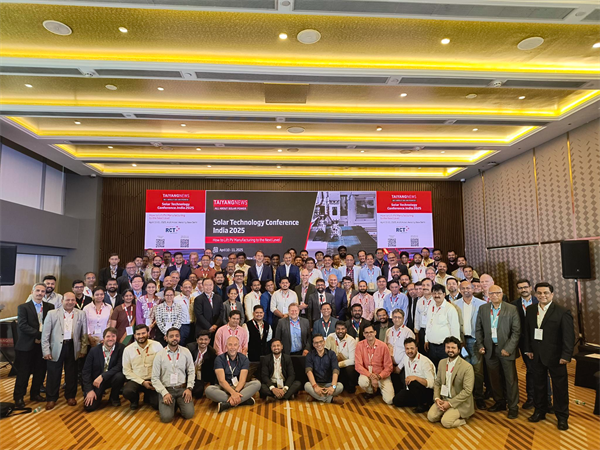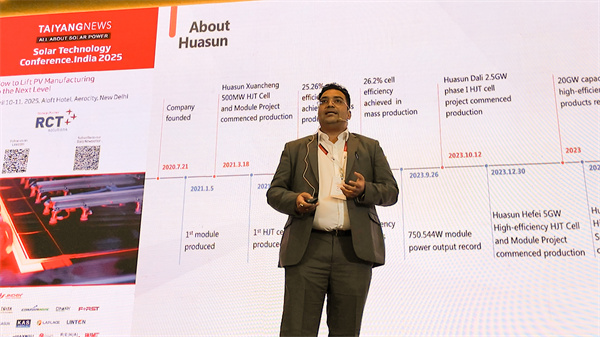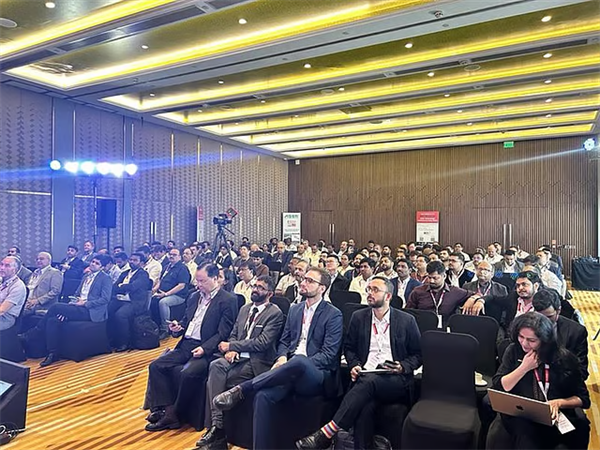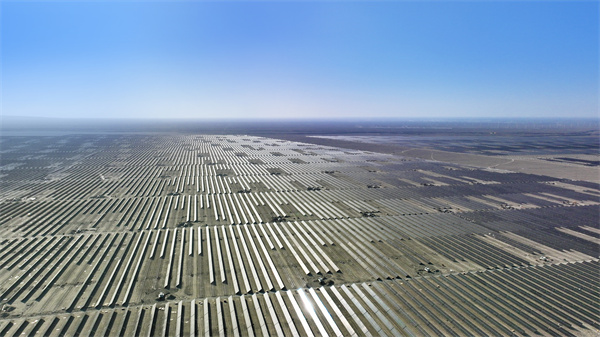en
On April 10th, Huasun Energy participated in the TaiyangNews Solar Technology Conference India 2025, reinforcing its commitment to advancing solar innovation in the region. During the conference’s core session, "Cell & Module Technologies – Status & Outlook", Abhishek Kaushal, Director South Asia of Huasun Energy, was invited to deliver a keynote speech titled "The Value Proposition of HJT in Today's Solar Technology Landscape."
In his address, Kaushal offered a comprehensive analysis of how heterojunction (HJT) solar technology presents innovative solutions that can support India in achieving its ambitious 2030 renewable energy targets. He emphasized the superior performance and environmental benefits of Huasun’s HJT products, citing impressive figures such as a 26.5% mass production efficiency, 95% bifaciality, and an ultra-low carbon footprint of just 366g CO₂ eq/W. These key advantages, he noted, position HJT as a critical enabler in accelerating India's transition to a sustainable energy future.

HJT: Driving India’s Green Energy Revolution
With over 3,000 annual sunshine hours, India is an ideal hub for solar development. Recent data reveals that India’s photovoltaic (PV) market has surpassed 100 GW, ranking third globally behind China and the U.S. The market is projected to grow at a compound annual growth rate (CAGR) of 13.1% from 2025 to 2034, with the nation aiming to reach 280 GW of cumulative PV installations by 2030—requiring an annual addition of approximately 30 GW.
In 2024, Huasun achieved Bureau of Indian Standards (BIS) certification, marking its official entry into the Indian market. Since then, the company has shipped over 100 MW of HJT modules to India, with its high-efficiency products gaining significant traction among local clients. Additionally, partnerships with Indian tracking system providers have facilitated the deployment of more than 50 MW of agrivoltaic projects, showcasing the adaptability of HJT technology to meet the diverse needs of the Indian market.

Technology as the Anchor: Redefining Solar Efficiency
As India accelerates its efforts toward achieving its 2030 renewable energy targets, HJT technology is emerging as a key driver of industrial innovation. During his presentation, Kaushal emphasized Huasun’s vertically integrated supply chain and large-scale manufacturing capabilities, which have enabled the company to achieve an average cell efficiency of 26.15% and a champion efficiency of 26.5%, surpassing the performance of conventional technologies.
Huasun’s HJT modules are rigorously tested for extreme environmental conditions, ensuring their reliability and durability. Additionally, their ultra-low carbon footprint of 366.12g CO2 eq/W—made possible by 120µm ultrathin wafers and a four-step low-temperature production process—presents a sustainable solution for India’s green manufacturing ambitions.

Multi-Dimensional Advantages for Localized Applications
In response to India’s growing demand for more efficient land use, Kaushal outlined Huasun’s multi-scenario solutions for HJT modules. Through detailed calculations, it was revealed that Huasun’s HJT modules, when installed vertically, deliver 10%-12% higher energy yields compared to other technologies of the same model, thanks to their outstanding bifaciality approaching 100%. This enhancement not only maximizes land use efficiency but also significantly reduces operation and maintenance costs.
Kaushal referenced the 1.8 GW Ruoqiang Project in China—the world’s largest single-site HJT power plant—as a prime example of HJT technology’s outstanding performance in high-irradiation regions. This project offers valuable insights that could support the development and construction of large-scale ground-mounted solar plants in India, further demonstrating the potential of HJT technology to meet the country’s energy and land efficiency goals.

Technological Outlook: From HJT to HJT-Perovskite Tandem
Looking ahead to the forefront of solar technology, Kaushal outlined the potential for integrating HJT and Perovskite tandem technologies, stating, "From HJT to Perovskite tandem, we are not only striving for breakthroughs in efficiency, but also focusing on rapidly industrializing and scaling up advanced technologies."
“India’s solar growth requires a strong synergy between cutting-edge technology and localization,” Kaushal concluded. “Huasun is dedicated to sharing its R&D expertise and fostering strategic partnerships to accelerate India’s renewable energy goals and support its green transition.”
This is the first one.